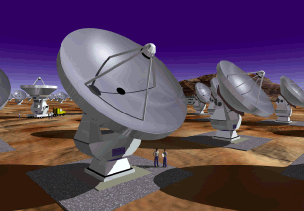TELESCOPES:
Atacama Large Millimeter Array (ALMA)
Robert C. Byrd Green Bank Telescope (GBT)
Very Long Baseline Array (VLBA)
DATA ARCHIVES:
OBSERVING PROPOSALS:
 ALMA conceptual images courtesy of the European Southern Observatory The telescopes of the National Radio Astronomy Observatory are designed to collect radio waves in an antenna, to distribute this information through a highly sensitive receiver and correlator and then to analyze the output with sophisticated software designed specifically for this purpose. The newest telescope project of the National Radio Astronomy Observatory is the Atacama Large Millimeter Array (ALMA). This endeavor includes the collaboration of observatories from around the world in the manufacturing of over 50 high-precision 12-meter antennas. ALMA will be the forefront instrument for studying the cool universe - the relic radiation of the Big Bang, and the molecular gas and dust that constitute the very building blocks of stars, planetary systems, galaxies, and life itself. The ALMA site is located at an elevation of 16,400 feet in Llano de Chajnantor, Chile. The Robert C. Byrd Green Bank Telescope (GBT) in Green Bank, West Virginia is the world's largest fully steerable radio telescope. The GBT is described as a 100-meter telescope, but the actual dimensions of the surface are 100 by 110 meters. The overall structure of the GBT is a wheel-and-track design that allows the telescope to view the entire sky above 5 degrees elevation. The track, 64 m (210 ft) in diameter, is level to within a few thousandths of an inch in order to provide precise pointing of the structure while bearing 7300 metric tons (16,000,000 pounds) of moving weight. The 140 Foot (43-m) Telescope.in Green Bank was completed in the Spring of 1965 and had its last regular observing run during the second quarter of 1999. It is being recommissioned for a collaboration by the Massachusetts Institute of Technology's Lincoln Laboratory and the NRAO to study turbulent properties of the Earth's ionosphere. The Very Large Array (VLA), one of the world's premier astronomical observatories, consists of 27 25-meter radio antennas each weighing approximately 200 tons, in a Y-shaped configuration on the Plains of San Agustin 60 miles west of Socorro, New Mexico. The data from the antennas are combined electronically to give the resolution of an antenna 36 km (22 miles) across, with the sensitivity of a single dish 130 meters (422 feet) in diameter. The VLA was made famous in the movie Contact starring Jodie Foster. The Expanded VLA Project will provide a radio telescope of unprecedented sensitivity, resolution, and imaging capability by modernizing and extending the existing Very Large Array. The Very Long Baseline Array (VLBA), remotely controlled from the Array Operations Center in Socorro, New Mexico, is comprised of ten 25-meter radio telescopes each weighing 240 tons, which work together as the world's largest, dedicated full-time astronomical instrument. From Mauna Kea on the Big Island of Hawaii to St. Croix in the U.S. Virgin Islands, the VLBA spans more than 5,000 miles, providing astronomers with the sharpest vision of any telescope on Earth or in space. Dedicated in 1993, the VLBA has an ability to see fine detail equivalent to being able to stand in New York and read a newspaper in Los Angeles. The VLA-Pie Town Link connects the VLBA Pie Town antenna and the VLA in real time via an optical fiber to increase the resolving power of the VLA's A configuration. The 12-meter millimeter-wave telescope on Kitt Peak, 50 miles west southwest of Tucson, Arizona, was closed as an NRAO facility in 2000 and is currently operated by Steward Observatory; more details are available on their web site. Astronomical data from NRAO telescopes are archived and cataloged in a Data Archive from which they are accessible by direct ftp downloads. The archive currently contains raw data from the GBT, VLA and the VLBA and catalog tables containing the meta-data from each observation. The archive currently resides at the NRAO Array Operations Center in Socorro, New Mexico. The data archive also contains calibrated data from NRAO-supported surveys, including:.
|